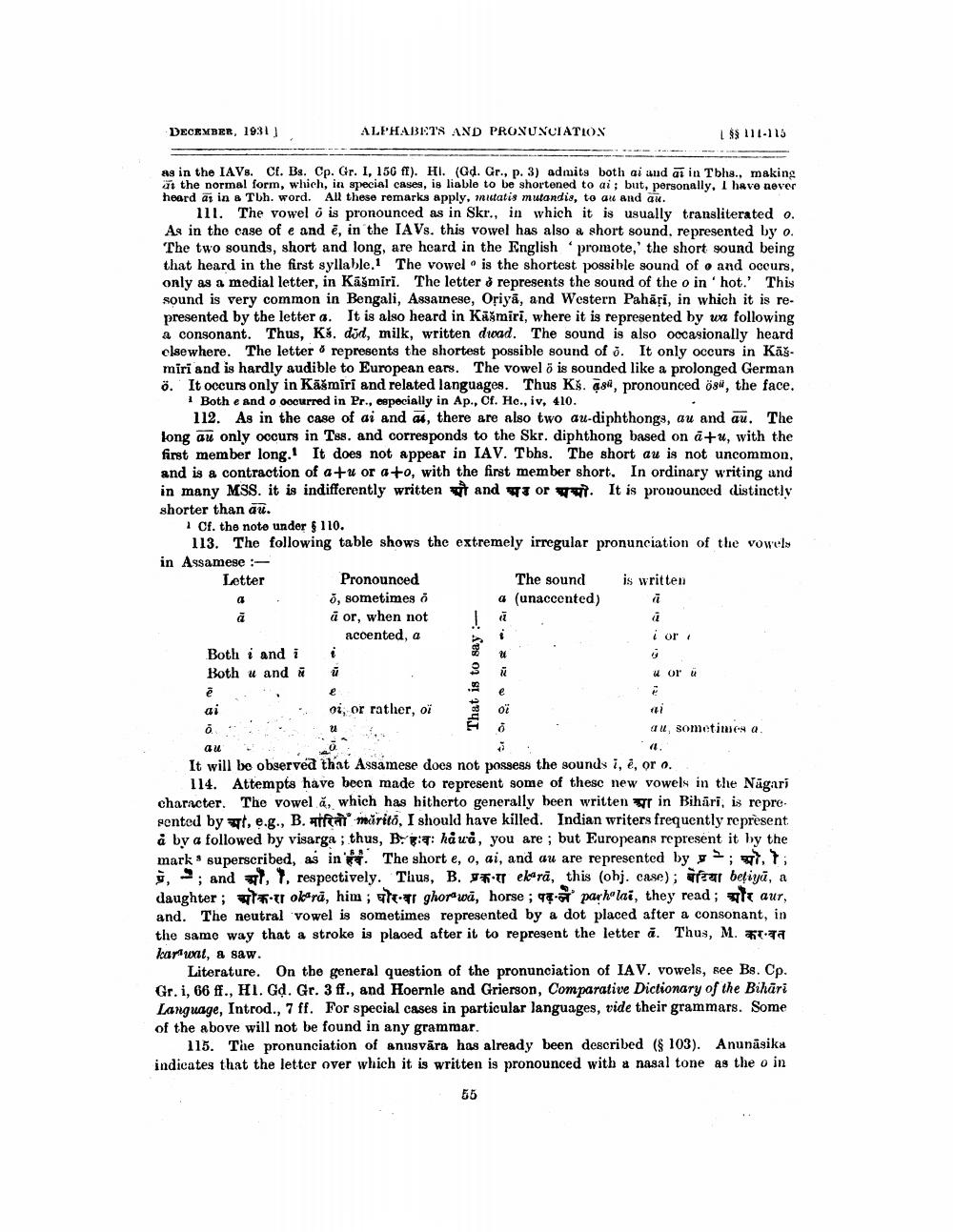________________
DECEMBER, 1931]
ALPHABETS AND PRONUNCIATION
1$$ 111-115
Ag in the IAV. Cl. Bs. Cp. Gr. I, 150 ft). HI. (Gd. Gr., p. 3) admits both ai aud ai in Tbhs., making at the normal form, which, in special cases, is liable to be shortened to ai; but, personally. I have never heard as in a Tuh. word. All these remarks apply, mutatis mutandis, to au and au.
111. The vowel o is pronounced as in Skr., in which it is usually transliterated o. As in the case of e and ē, in the IAVs. this vowel has also a short sound, represented by o. The two sounds, short and long, are heard in the English 'promote,' the short sound being that heard in the first syllable. The vowel is the shortest possible sound of o and occurs, only as a medial letter, in Kášmiri. The letter o represents the sound of the o in hot.' This sound is very common in Bengali, Assamnese, Oriya, and Western Pahāļi, in which it is represented by the letter a. It is also heard in Kāšmiri, where it is represented by wa following a consonant. Thus, Ks. död, milk, written droad. The sound is also occasionally heard clsewhere. The letter represents the shortest possible sound of o. It only occurs in Kāšmiri and is hardly audible to European ears. The vowel ő is sounded like a prolonged German ö. It occurs only in Kāšmiri and related languages. Thus Kš. 288, pronounced ösü, the face.
Both e and o occurred in Pr., especially in Ap., Cf. Ho., iv, 410.
112. As in the case of ai and 4, there are also two au-diphthongs, au and au. The long au only occurs in Tss. and corresponds to the Skr. diphthong based on a+u, with the first member long. It does not appear in IAV. Tbhs. The short au is not uncommon, and is a contraction of a+u or a +o, with the first member short. In ordinary writing and in many MSS. it is indifferently written and or 9. It is pronounced clistinctly shorter than au.
1 Cf. the note under $110.
113. The following table shows the extremely irregular pronunciation of the vowels in Assamese : Letter Pronounced
The sound is written ö, sometimes
a (unaccented) à or, when not accented, a
i or Both i and i i Both u and u
u or u
That is to say :
DO SZI
oi, or rather, oi
au sometimes a. au
o It will be observed that Assamese does not possess the sounds i, e, or o.
114. Attempts have been made to represent some of these new vowels in the Nāgari character. The vowel a, which has hitherto generally been written in Bihāri, is repre. pented by , e.g., B. Att mărită, I should have killed. Indian writers frequently represent å by a followed by visarga ; thus, B. :: hå ud, you are ; but Europeans represent it by the mark: superscribed, as in **. The short e, o, ai, and au are represented by ys; 7; ů. . and respectively. Thus, B. *t ekarā, this (obj. case); car bețiyā, a daughter; trokarā, him; het ghor wā, horse ; 98.0 parh"lai, they read; at aur, and. The neutral vowel is sometimes represented by a dot placed after a consonant, in the same way that a stroke is placed after it to represent the letter a. Thus, M. 1:20 kartwat, a saw.
Literature. On the general question of the pronunciation of IAV. vowels, see Bs. Cp. Gr. i, 66 ff., HI. Gd. Gr. 3 ff., and Hoernle and Grierson, Comparative Dictionary of the Bihāri Language, Introd., 7 ff. For special cases in particular languages, vide their grammars. Some of the above will not be found in any grammar.
115. The pronunciation of anusvāra has already been described (f 103). Anunasika indicates that the letter over which it is written is pronounced with a nasal tone as the o in
15




